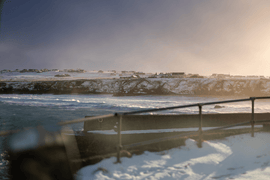There’s something magical about Burns Night in Scotland. It’s a celebration of culture, poetry, and the beauty of the Highlands. This day has been celebrated every year since 1801 as a tribute to the life and works of the famous Scottish bard, Robert Burns. In Applecross, we’re having a community Burns Supper on Friday, but I’m sure plenty of us will be enjoying haggis (or, as Rabbie puts it, the ‘Great Chieftain o’ the Puddin-race!’) and perhaps a dram or two!
What is Burns Night? A Celebration of Scotland’s Traditions
Every year on 25th January, Scotland honours its beloved national bard, Robert Burns. Known affectionately as “Rabbie,” Burns wrote poetry that captured the heart of Scotland, its people, landscapes, and soul. Burns Night is a time to gather, reflect on his legacy, and revel in the rich culture of the Highlands.
Who Was Rabbie Burns?
Born in 1759, Robert Burns is celebrated as Scotland’s greatest poet.
- His works championed universal themes of love, nature, and humanity, often infused with humour and passion.
- One of his most iconic poems, My Heart’s in the Highlands, pays tribute to Scotland’s rugged landscapes and deep emotional connection to the land.
How is Burns Night Celebrated?
Burns Night is rich with tradition. Here are the key elements of the celebration:
- Haggis Ceremony: The centrepiece of any Burns Supper, the haggis is brought in to the sound of bagpipes and ceremoniously addressed with Burns’ poem, Address to a Haggis.
- Whisky Toasts: No Burns Night is complete without a dram of Scotland’s finest.
- Poetry and Song: Guests recite Burns’ poems and sing traditional Scottish songs such as Auld Lang Syne.
- Ceilidh Dancing: The night often ends with a ceilidh, a lively traditional dance.
Burns Night isn’t just an event—it’s a heartfelt celebration of Scotland’s heritage.
Applecross: A Highland Gem for Burns Night
Nestled on Scotland’s remote west coast, Applecross is the perfect place to celebrate Burns Night. Its dramatic landscapes and tight-knit community create an atmosphere steeped in tradition and charm.
On this day, Jack also remembers the clear winter’s night when he captured the Burns Night Aurora image, back on 25th January 2021.

The Story Behind the Photo: Capturing the Aurora on Burns Night
As a photographer and lover of the Highlands, capturing the aurora borealis in Applecross had been a long-held dream. On this Burns Night, everything aligned perfectly, a rare moment of poetic serendipity.
-
A Rare Aurora Display: Auroras on Scotland’s west coast are notoriously elusive due to frequent clouds and rain in winter. But this night was different. Under the glow of a supermoon, the skies were unusually clear, revealing the aurora in all its glory.
-
A Landscape Illuminated: The supermoon added a unique touch, lighting up the landscape and providing extraordinary detail.
- Green aurora reflections danced on the still water, while the warm lights of Milton village contrasted beautifully with the snow-capped hilltops.
- Even the stars were bright enough to reflect in the water, creating a truly magical scene.
This image was not just a photograph but a visual ode to the Highlands, blending one of the most magical elements of our skyline with the poetic spirit of Burns Night.

Tips for Capturing the Aurora in the Highlands
Want to capture your own aurora moment in Scotland? Here are some tips to help you plan and succeed:
-
When and Where to See Auroras in Scotland:
- Best Times of Year: Late autumn to early spring offers the longest nights, ideal for aurora spotting.
-
Top Locations:
- Applecross (for remote, dark skies).
- Caithness and Sutherland.
- The Isle of Skye.
- Conditions to Watch For: Clear skies, low light pollution, and strong geomagnetic activity (KP index of 4 or higher).
-
Practical Tips for Aurora Photography:
-
Gear Recommendations:
- A DSLR or mirrorless camera with manual settings.
- A wide-angle lens with a fast aperture (f/2.8 or lower).
- A sturdy tripod.
-
Camera Settings:
- ISO: Start with 1600-3200.
- Shutter Speed: 5-15 seconds (adjust based on aurora movement).
- Aperture: Wide open (e.g., f/2.8).
-
Other Tips:
- Use a remote shutter release or timer to avoid camera shake.
- Dress warmly, Highland nights can be freezing!
- Be patient; auroras are unpredictable but worth the wait.
-
Gear Recommendations:
Reflections on Burns, the Highlands, and Nature’s Poetry
Burns Night is more than just a celebration of tradition, it’s a chance to reflect on the beauty of Scotland’s culture and landscapes. That year, witnessing the aurora in Applecross felt like stepping into one of Rabbie Burns’ poems.
As Burns wrote in My Heart’s in the Highlands:
"My heart’s in the Highlands, my heart is not here,
My heart’s in the Highlands, a-chasing the deer…"
His words capture the timeless allure of the Highlands, a place where tradition and nature come together in harmony.
Whether you’re drawn to Scotland for its cultural heritage, stunning landscapes, or opportunities to witness the northern lights, Burns Night offers a unique window into everything that makes the Highlands special.
FAQs About Burns Night and Aurora Spotting in Scotland
What is traditionally eaten on Burns Night?
The main course is haggis, served with “neeps and tatties” (mashed turnips and potatoes). Dessert often includes cranachan, a mix of whipped cream, oats, raspberries, and whisky.
When is the best time to see the aurora in Scotland?
The best months are from October to March, with the highest chances during cold, clear nights.
Where can I find a Burns Night celebration in Scotland?
Burns Night is celebrated across Scotland in homes, pubs, and community halls. For a unique experience, head to smaller Highland communities like Applecross.
Do I need special equipment to photograph the aurora?
Yes, a camera with manual settings and a tripod are essential for capturing the aurora’s beauty.



